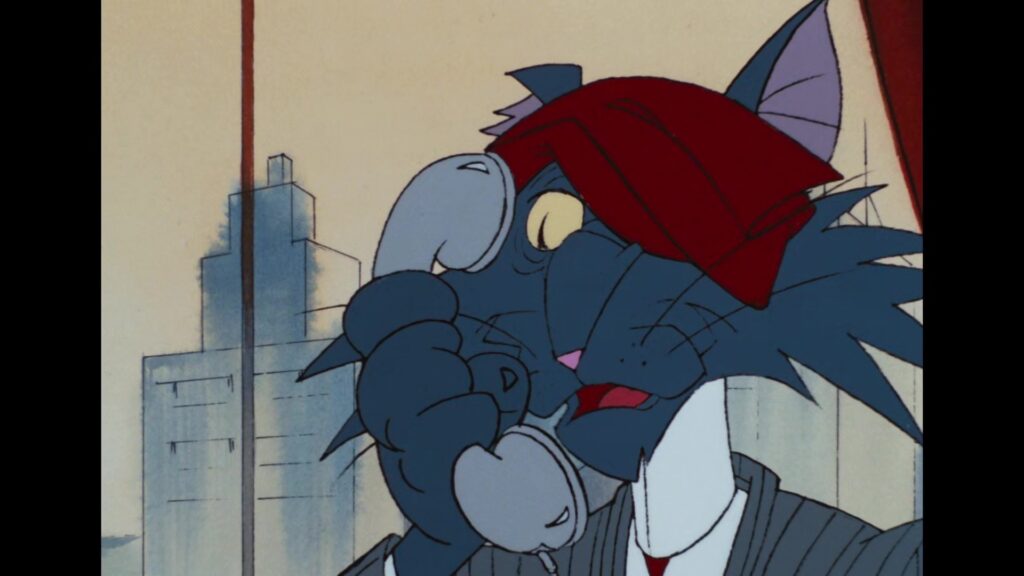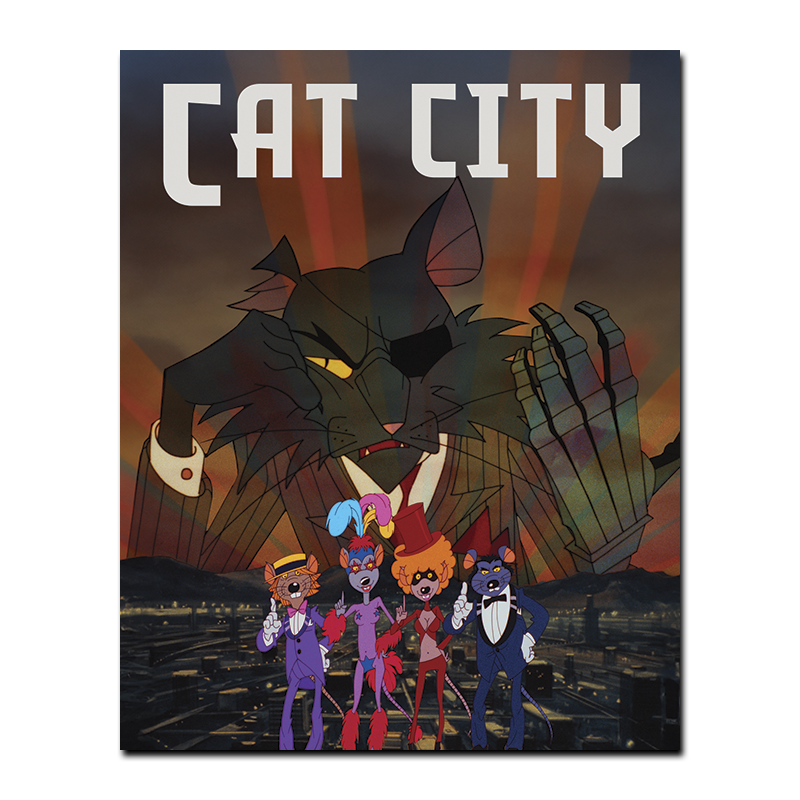Brave the Carpathian wilds of Hungarian animated cinema, and sooner or later you’ll encounter a film called Cat City. Thanks to a fantastic reissue by Deaf Crocodile, there’s no reason it can’t be “sooner”.
Directed by Béla Ternovszky and released in 1986 as Macskafogó (“Cat Catcher”), it’s different to the other Pannónia Film Stúdió movies gaining popularity in the west. Marcell Jankovics’ Fehérlófia was a rapturous hewn-from-the-flesh-of-gods primordial Urheimat myth; György Kovásznai’s Habfürdö was a radical Warhol-meets-Schiele-meets-Soviet-Central-planning romcom. Cat City finds a different way to surprise: by being familiar.
The movie tips its hand early, when a Star Wars text-crawl tells us “In 80 AMM (After Mickey Mouse) the mice of Planet X were threatened by…” What follows is a broad spoof of James Bond and Dirty Harry, where retired “Intermouse” agent Nick Grabovski must recover plans for a device that will save mousekind from a race of evil felines.
Cat City is essentially a western chase cartoon jacked up on espionage steroids—The Mouse With A Golden Gun. Octopussycat. Tom and Jerry Never Dies—with its spy movie hijinks subtly twisted by the fact that they’re about animals. Nick doesn’t have “Bond gadgets”. He uses rodently attributes to get out of trouble (he gnaws through things with his teeth, and picks locks with his tail). The main cat villain has a prosthetic metal hand, like Dr No. The other main villain (?!) is Ernst Blofeld’s white cat. It’s not subtle.
James Bond is conceptually inseparable from Cold War paranoia, so Cat City feels provocative simply by existing. Eastern European baddies with fake accents are the villains in something like every Bond film ever made. Was there public demand for a “we have Sean Connery at home” Magyar imitation? Apparently so. The film was very successful.
But I’m curious as to how familiar, exactly, the average Hungarian would have been with the things Cat City parodies. Here’s a contemporary review (in Hungarian, but Google translates it readably) by Filmvilág‘s Gabriella Székely, who comments that much of the film is cribbed from media that nobody in Hungary can watch. On the other hand, Budapest had at least one cinema in the 1980s that played western movies. On Quora, Viktor T Toth reminisces…
A friend of mine and I saw Monty Python and the Holy Grail here. We were not familiar with Monty Python at the time, so we were completely unprepared. To this day, I don’t know how I managed to avoid wetting myself, I was laughing so uncontrollably at times. Other movies of the era that I remember include Alien (very popular in Hungary, despite the awkward title, apparently borrowed from the French, which literally translates back as “The Eighth Passenger is Death”)…
Hungary, under János Kádár, was the Eastern Bloc’s most liberal state, and an unofficial state attitude of “gulyáskommunizmus” (“goulash communism”) extended a certain permissiveness to the arts. In 1968, deputy Prime Minister György Aczél issued a statement “accepting any […] artistic expression of genuine value, even if it was produced by Western bourgeois culture.” Cases of censorship still occurred, but there were certainly tougher places in the Soviet Union to watch (and make) a James Bond parody.
It wasn’t always this way. The lot where Pannonia Films once existed is fifteen minutes away from the House of Terror, a museum dedicated to the victims of the Államvédelmi Hatóság, Hungary’s secret police. Many of the killed and tortured were actors, writers, and filmmakers. Hungary’s animation industry was nationalized around 1950 as Magyar Szinkronfilmgyártó Vállalat (the proto-Pannónia). Most of its early output tended to be didactic, safe, and moralistic fare aimed at children, but by the 60s and 70s, a spirit of restless experimentation was emerging, all but encouraged by the state.
Hungary occupies a geographically ambiguous part of Europe—Central Europe by some maps, Eastern Europe by others—and under Kádár it had politics to match, with loyalties cleft between the decrepit Soviet giant to the east and the rising sources of capital in the west. When the USSR collapsed, Hungary was the first domino to fall. The Berlin Wall symbolically marked the end of the Iron Curtain, but the beginning arguably came in April 1989, when Hungary dismantled its border fence to Austria.
Was 1980s Hungary a Goldilocks zone for the arts? Isolated enough to have a national style; yet open enough that foreign ideas like James Bond could trickle through? Rich enough to support a film industry; yet poor enough that it avoided the fate of 1980s Hollywood—economically minmaxed by capital into a depressing prolefeed machine? Oppressive enough to stimulate art; yet free enough that this art was allowed a voice? The idea is striking, but likely reductive.
Likewise, it’s tempting to read (and probably misread) broad Cold War concerns into Cat City. Are the cats meant to symbolize anything in particular? At times they behave like a crime syndicate, robbing mice of their possessions. At other times they’re a KGB-esque spy network, surveilling the mice. Yet they’re also a hostile state power, seeking the genocide of the mouse race. They’re like a vague (and sometimes contradictory) conglomerate of Nazis, Soviets, and mafia. Any political allusions are likely nebulous, and buried beneath ersatz James Bond and goofy jokes. The villainous Mr Teufel’s first name is a Germanic “Fritz”: you can that as a political statement, but a more likely reference is Bakshi’s Fritz the Cat.
That said, there is a striking shot where Mr Teufel is wiping his brow with a handerchief, he throws it over his head, and it lands over one eye, looking like Hitler’s combover.

This is an “adult animation”, but only in the sense that Paul McCartney “rocks hard”. There’s some light PG-rated sexual references. Characters have names like Pissy, Pukie, and Lusta Dick. A few gags have a mordant, subversive edge. The basic scenarios—such as a bank robbery, a heist on a supertanker, and an all-out urban battle—are adapted from adult movies (or at least movies watched by adults) like Dirty Harry, The Spy Who Loved Me, and Death Wish 3 (maybe not the 3rd, which came out pretty close to Cat City’s release.) Otherwise, the movie is pretty kid-friendly. Hungarian animated films tended to muddy the lines between adult and children’s cinema—Feherlofia blended dick jokes with fairytale storytelling—and this is of a piece with that. Children can surely relate to the plight of these small creatures as they try to avoid being eaten by vampire bats. That is the world they live in.
At the center of the movie are “The Four Gangsters”: a quartet of rats who are good at self-promotion but little else. Teufel hires them to kill Grabowsky, a task they fail dismally (and hilariously) at. They get a huge amount of character development, but even though ultimately could be cut with no impact on the plot, they improve leaven the mix with some Keystone Kops-esque absurdity. The Four Gangsters feel like a reference to something that a Hungarian audience would be more familiar with than I am.
As far as comedy goes…well, James Bond has been pretty much spoofed to death for me. Having the villain say “Welcome…Mr Grabowsky” doesn’t even register as a parody. It’s like doing a fake Arnold Schwarzenegger voice—you make that kind of joke when you’re a person who doesn’t really watch many movies.
The trouble with satire is that you now have two ways of failing. Either the thing you’re spoofing will become old and forgotten (leaving the movie shadowboxing at nothing), or the parody will itself fail. In some ways, western audiences are as culturally distinct from Connery-era Bond as we are from gulyáskommunizmus-era Budapest. And while the classic James Bond movies are influential and cast a long shadow, Bond seldom crosses my radar at all, except for random culture war stuff about how to reconstruct him so he’s Relevant(tm) for Today’s Audience(tm) (you know what I mean—arguments about whether Bond should be a black woman who believes #ConsentIsSexy and so on.) The character increasingly seems cut off from the now: more like a work of cultural taxidermy than a living, breathing property.
I’m reminded of Elvis’s 1968 hit “A Little Less Conversation”, which was remixed by Junkie XL in 2003, and then hit number one in nine countries. Some took it as a sign of The King’s enduring cultural legacy. Yet Elvis was so buried in the mix, so out-of-place in the modern production and big-beat trappings, that it had the opposite effect for me. He felt irrelevant. It was as if we, as a civilization, were saying “yes, Elvis is important. But let’s be real, nobody actually wants to hear him, unless we dress him up in modern drag.”
I’ve wandered a bit from the point, but the question of how much you enjoy Cat City’s largely rests on how much you enjoy other, fairly old movies. In 2024, I’m now convinced that the Bond parody stuff is the least interesting side of Cat City. It’s far less sharp than even something like Austin Powers, and its barbs are further blunted by time and culture. Mostly, I’m surprised by how distant James Bond himself feels. Too far to even take potshots at anymore. If you’d asked a person in 1970 whether James Bond would last longer in culture than Sherlock Holmes, I don’t think many moviegoers would have put money on Doyle’s detective.
Cat City definitely nails the racial and gender politics of a classic Bond film. The vampire bats are cartoonish Mexican stereotypes who wear sombreros and play mariachi music. There’s a Japanese cat who attempts to trap Grabowski while the “Chinaman riff” plays. There’s a sexy mouse geisha, who is effortlessly seduced by Grabowski at the end, despite having no chemistry established. It’s all played for fun; a slightly naff recreation of Hollywood stereotypes.

So what do I think of Cat City?
Well, it has a lot of charm. It’s also a bit baggy, feeling every minute of its 1:33:00 runtime. A number of gags just don’t work because they’re dragged out, and lack rhythm and timing. The scenes of Teufel terrorizing and maiming his put-upon assistant, Mr Safranek, should have been funny, but they just go on and on, and become uncomfortable.
The story also needed a haircut. It has numerous plot digressions that don’t really go anywhere and are dropped by the end—Safranek’s daughter has a pet mouse, and their relationship is played up for its taboo potential, but this ultimately gets forgotten about. Animated films are normally very “tight”—one of the blessings of a 3-year production cycle is that it gives you ample time to work out what film you’re actually making—so it’s odd to see one second guess itself and go down blind paths.
The adventures are suitably Bond-esque, with setpieces involving mountain roads, submarines, high-tech cars, etc. Grabowsky is so competent and capable (and his opponents so moronic) that he never feels in much danger. Incredibly, the Four Gangsters rank among his tougher adversaries!
The animation is good, but static. Shots are locked-down and stiff. Characters exist on flat planes of action, like comic book panels. There’s little of the camera movement or layered multiplane action of a Disney movie.
But its flaws make it interesting, in a rough-hewn, shaggy way. It’s reactive, in a sense, and can’t be watched on its own like Feherlofia can. There’s a still a lot of creative juice inside it. I kept pausing to admire certain shots, such as how Mr Teufel’s smoke floats across the room and weaves a noose around his put-upon subordinate Safranek’s head. It certainly has the Pannonia energy. It’s not altogether successful, but it is memorable: a weird island of convention inside the bubbling goulash of Magyar animation.
No Comments »
Comments are moderated and may take up to 24 hours to appear.
No comments yet.

